All published articles of this journal are available on ScienceDirect.
Numerical Analysis of Strength Capacity of High-Performance Reinforced Concrete Columns with Varied Parametric Study
Abstract
Introduction:
This study includes the analysis of the strength capacity of high performance reinforced concrete columns subjected to concentric axial loading. The main variables are based on the compressive strength of concrete and steel reinforcing ratios. All the columns are fixed, supported by two ends.
Methods:
This study is based on a calculation done according to ACI Code-318M-2011 equations for columns analysis to evaluate the ultimate strength then applied these load on samples to compare between them by software program Prokon V.3. The comparison is based on reinforcement ratio and moment resistance capacity.
Results:
The analysis results show that when increasing the main reinforcement with high-performance concrete led, there will be an increased load capacity by about (40 to 215%) and moment resistance capacity by about (35 to 50%) with the same load conditions. According to the analysis of the results, the moment resistance capacity of constant sample value with different reinforcing ratio leads to these resist depending on the load applied, and the concrete compressive strength of columns.
Conclusion:
Reasonable correlation of the results is demonstrated, which ensured the adequacy of the analysis by test program, both hand calculation and software Prokon.V.3.
1. INTRODUCTION
Reinforced concrete columns have an embedded steel mesh (known as rebar) to provide reinforcement. The design of the reinforcement can either be spiral or tied. Spiral columns are cylindrical with a continuous helical bar wrapped around the column. This spiral provides support in the transverse direction [1, 2]. Tied columns have closed lateral ties spaced approximately and uniformly across the columns. The spacing of the ties is limited in that they must be close enough to prevent failure between them and far apart enough that they do not interfere with the setting of the concrete [3, 4]. This study involves square or rectangular columns. They are generally used in the construction of buildings. It is much easier to construct and cast rectangular or square columns than circular ones due to ease of shuttering and to support it from collapsing [5], resulting from the pressure while the concrete is still in flow-able form. The different shapes of R.C. columns (square or rectangular) and cross-section layout, as shown in Figs. (1 and 2), respectively.
1.1. Comparison between High and Normal-Strength Concrete
The primary difference between high-strength concrete and normal-strength concrete relates to the compressive strength that refers to the maximum resistance of a concrete sample to applied pressure [6, 7]. Although there is no precise point of separation between high-strength concrete and normal-strength concrete, the American Concrete Institute defines high-strength concrete as concrete with a compressive strength greater than 6,000 psi. Likewise, there is no precise point of separation between high-strength concrete and ultra-high-performance concrete, which is of greater compressive strength than high-strength concrete and other superior properties.
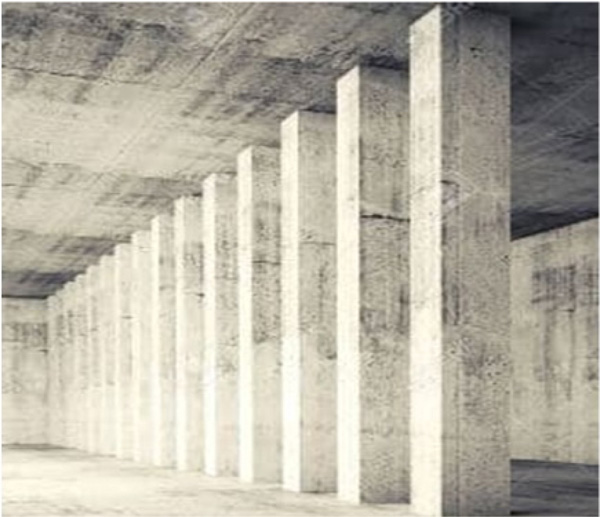
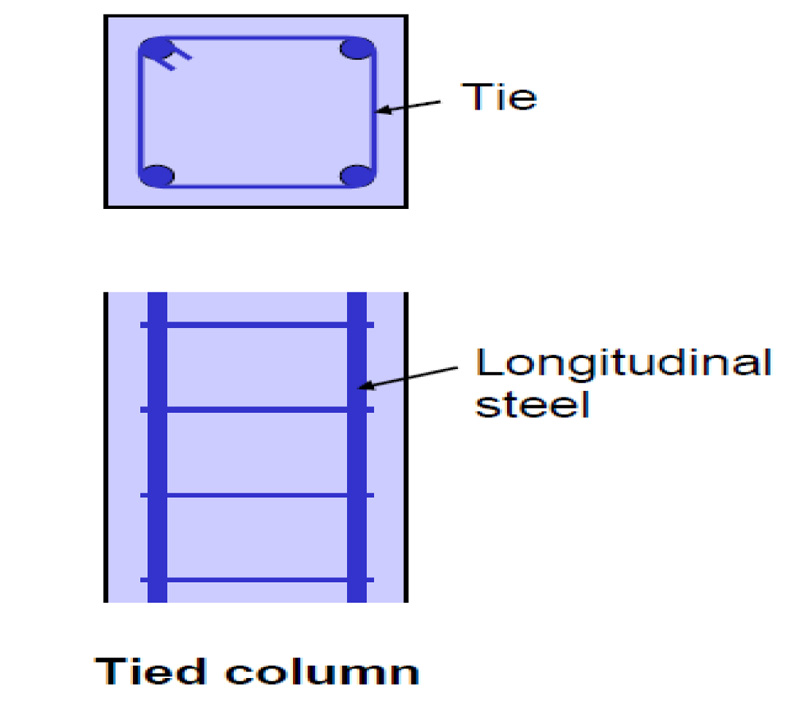
1.2. High-Strength Concrete History
In the early 1970s, experts predicted that the practical limit of ready-mixed concrete would unlikely exceed a compressive strength higher than (75.84MPa) 11,000 pounds square inch (psi). Over the past two decades, the development of high-strength concrete has enabled builders to meet and surpass this estimate easily. Two buildings in Seattle, Washington, contain concrete with a compressive strength of (131.0 MPa) 19,000 psi. [8].
2. MATERIALS AND METHODS
The study is direct to:
● Investigate, by analysis using ACI318-11 Code procedure, and determine the ultimate load-carrying capacity of reinforced concrete columns.
● Investigate numerically by analysis of reinforced concrete columns by used program package ProkonV.3 and evaluate the analysis results based on the design steel reinforcing required and moment resistance provided by these samples.
● Find a simple tool for comparing manual calculations with the results obtained from engineering programs that help in carrying out appropriate solutions, whether for design engineers, consultants or site engineers to take appropriate precautions for occupational and economic safety and maintain the facility.
● Study the behavior of R.C. columns with high-performance concrete with different variables such as:
1- Compressive strength values.
2- Reinforcement ratio of the columns samples.
3. ANALYZING OF HIGH STRENGTH REINFORCED CONCRETE SHORT COLUMNS IDEALIZATION
3.1. ACI Code 318M-2011
Columns can broadly be classified as short and slender columns based on their slenderness ratio. The slenderness ratio of a concrete column is defined as the ratio of its effective length le to its least lateral dimensions. The effective length is the unsupported length multiplied by a factor usually specified in the design codes depending on the end conditions of the column. Each code has its criteria for classifying column as either short or slender [9, 10]. The samples details are shown below:
In this study, all columns were square section with the following properties:
The main variables taken in this study are:
1- The Cubic compressive strength of concrete.
2- The steel reinforcement ratios.
The cubic compressive strength of concrete taken in this study are of different values to show the effect on the performance of reinforced concrete axially loaded columns. While the minimum longitudinal steel percentage is 1%, and the maximum percentage is 8% of the gross area of the section (ACI Code, Section 10.9.1). Minimum reinforcement is necessary to provide resistance to bending, which may exist, and to reduce the effects of creep and shrinkage of the concrete under sustained compressive stresses [11]. Practically, it is very difficult to fit more than 8% of steel reinforcement into a column and maintain sufficient space for concrete to flow between bars [12]. The columns dimension and properties, as listed in Table 1. While the variables i.e. (ƒcu and ρg) with different columns samples, are shown in Table 2.
| L, mm | b, mm | h, mm | fy, MPa |
| 3000 | 300 | 300 | 420 |
| ƒcu , MPa | 30 | 60 | 90 | 120 |
|
gρ % |
0.02 | 0.02 | 0.02 | 0.02 |
| 0.04 | 0.04 | 0.04 | 0.04 | |
| 0.08 | 0.08 | 0.08 | 0.08 |
From variables listed in Table 2 can construct three groups of samples (i.e., Twelve samples) to analyze based on steel reinforcing ratio i.e., R.C. columns samples with different variables, as shown in Table 3.
| Item | Sample | ƒcu, MPa | ρg % |
| Group 1 | C11 | 30 | 2% |
| C12 | 60 | 2% | |
| C13 | 90 | 2% | |
| C14 | 120 | 2% | |
| Group 2 | C21 | 30 | 4% |
| C22 | 60 | 4% | |
| C23 | 90 | 4% | |
| C24 | 120 | 4% | |
| Group 3 |
C31 | 30 | 8% |
| C32 | 60 | 8% | |
| C33 | 90 | 8% | |
| C34 | 120 | 8% |
3.1.1. The Behavior of Axially Loaded Columns by Analysis Equations of ACI Code 318M-2011
When an axial load is applied to a reinforced concrete short column, the concrete can be considered to behave elastically up to low stress of about (fc`/3). If the load on the column is increased to reach its ultimate strength, the concrete will reach the maximum strength, and the steel will reach its yield strength, ƒy [13]. The nominal load and ultimate load capacity of the column can be written as follows [14]:
 |
(1) |
 |
(2) |
where:
Pu: ultimate load capacity ; Pn: nominal load; Ø: strength reduction factor equal to 0.65 for tied columns.
ƒc`= 0.8*ƒcu
ƒc`= cylinder compressive strength of concrete.
ƒcu: Cubic compressive strength of concrete; ƒy: Yield strength of steel reinforcing.
Ag: Gross Concrete Area; Ast: total steel compressive areas.
3.1.2. Load Capacity Results by ACI-Code 318M-2011
After the analysis manually calculated based on Eqs. (1) and (2) according to ACI 318M-2011 Code, the same procedures are used for all groups to evaluated the performance of R.C. columns based on ultimate strength capacity. The analysis results of the ultimate load based on ACI318M-2011 procedures are shown in Table 4.
| Item | Sample | ƒcu, MPa | ρg % | Pu, kN | Increased% Pu |
| Group 1 | C11 | 30 | 2% | 1487 | --- |
| C12 | 60 | 2% | 2522 | 70% | |
| C13 | 90 | 2% | 3601 | 142% | |
| C14 | 120 | 2% | 4680 | 215% | |
| Group 2 | C21 | 30 | 4% | 1783 | --- |
| C22 | 60 | 4% | 2840 | 60% | |
| C23 | 90 | 4% | 3898 | 118% | |
| C24 | 120 | 4% | 4955 | 178% | |
| Group 3 |
C31 | 30 | 8% | 2464 | --- |
| C32 | 60 | 8% | 3478 | 41% | |
| C33 | 90 | 8% | 4491 | 82% | |
| C34 | 120 | 8% | 5505 | 123% |
From the analysis, results can show when increased cubic compressive strength of concrete by about (100%) led to increasing the ultimate load by about (40-70%), also when increased cubic compressive strength of concrete by about (200%) led to increasing the ultimate load by about (80-140%) and when increased cubic compressive strength of concrete by about (300%) led to increasing the ultimate load by about (120-215%). Accordingly, results can also show clearly that the suitable reinforcing ratio used of (2%) when comparison based on steel reinforcing ratio i.e. this value of group one of ratio give more enhancement with cubic compressive strength of concrete slightly increased, While the steel reinforcing ratio of (4% and 8%) i.e. group two and three give less enhancement of ultimate load than group one (2%) ratio by about (30-100%). These differences are due to the steel reinforcing contributed in ultimate strength capacity i.e. the increased steel ratio by about (100%-200%) led to increased, ultimate load by about (15-22%), keeping other properties constant. Results show the increased compressive strength suitable for the used optimum steel reinforcing ratios. The comparison between samples based on variable i.e.(cubic compressive strength of concrete ƒcu) is shown in Fig. (3).
The comparison between column samples based on cubic compressive strength of concrete ƒcu or steel reinforcing ratio ρg to evaluated ultimate load capacity is shown in Figs . (4 and 5).
4. RESULTS AND DISCUSSION
4.1. ANALYSIS OF HIGH-PERFORMANCE STRENGTH REINFORCED CONCRETE COLUMNS BY PROGRAM PROKON V.3.0
Prokon is a program used for the structural analysis and design for timber, concrete, and steel according to a number of design codes. This program is able to design individual structural members such as rectangular columns, concrete slabs footings, and retaining walls separately, according to a number of design codes. Prokon provides a friendly graphical user interface for continuous error checking during the input; the tabular editor makes it easy to find and fix input problems [15, 16]. The analysis results obtained from Prokon V.3. program that used to analyze and study different variables that affect the behavior of reinforced short columns and columns under axial loads. The same dimension and variables of these columns are used in the analysis.
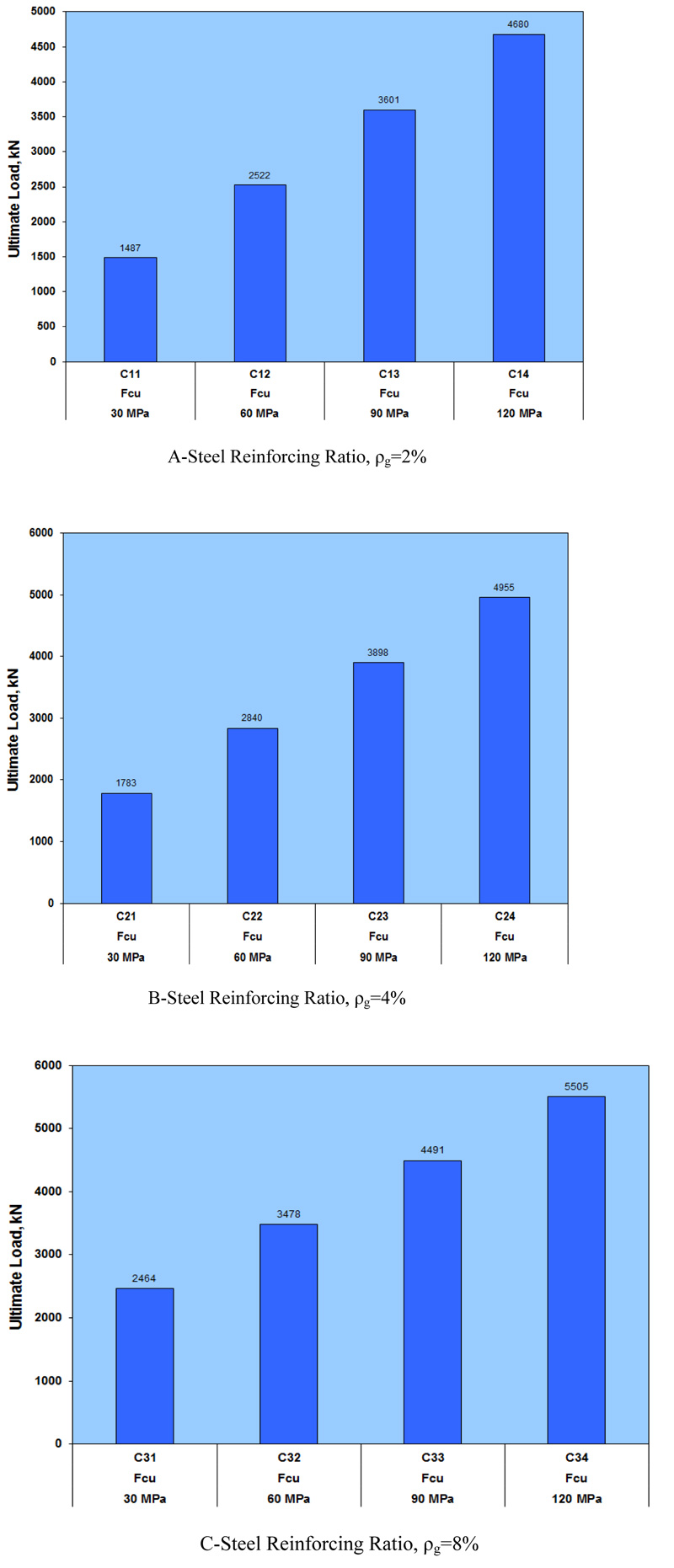
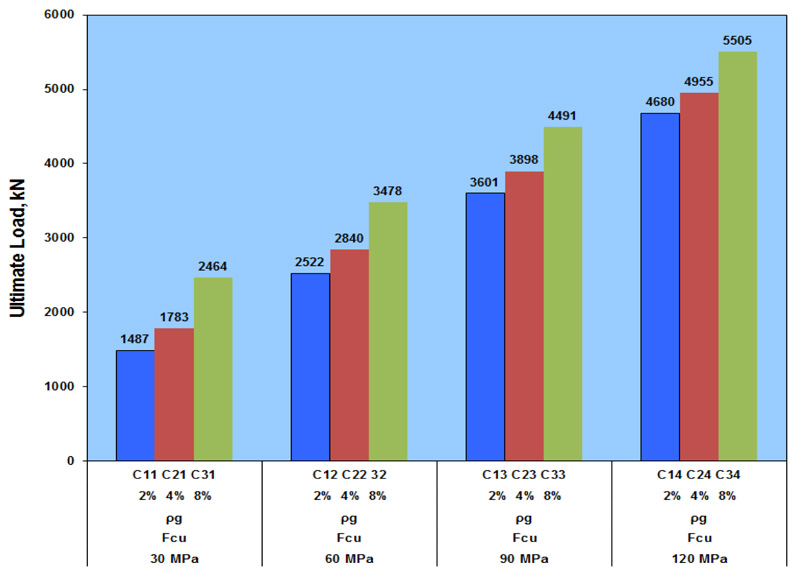
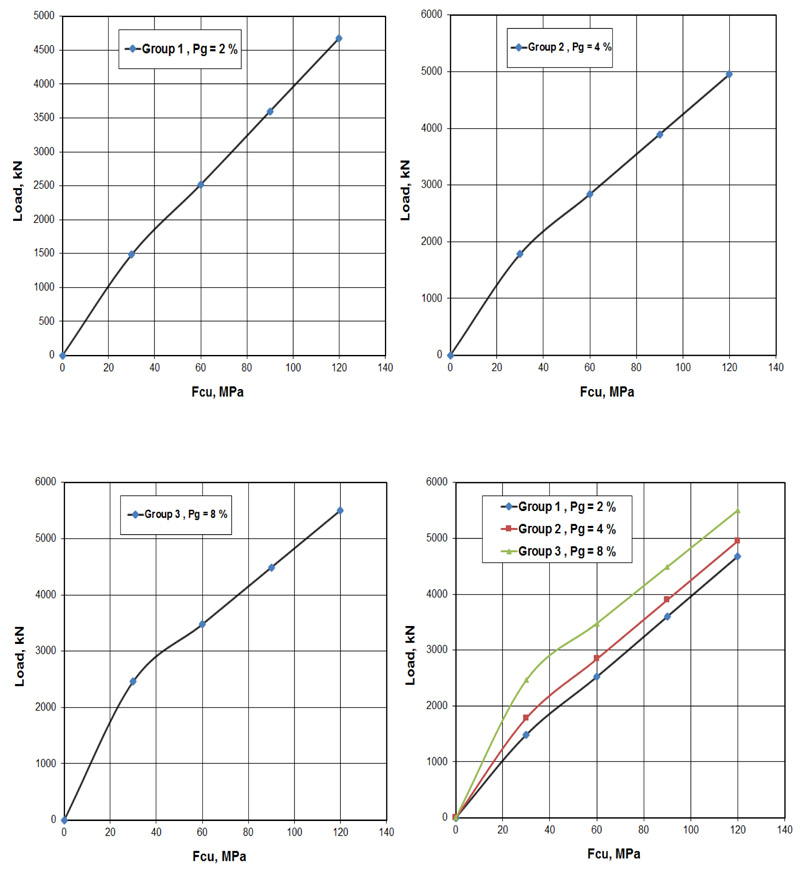
4.1.1. Load Cases
The different load cases that are applied on the columns were obtained from the dead load, and live load that can be applied in the local sites approximately equals or in near values to the results from ACI-318M-11 code calculation. These loads are applied as steps load cases for different variables to show that the effect of these load on the behavior of columns is based on the analysis of reinforced concrete columns according to default code in program analysis [17] (Prokon V.3.0), the load’s cases (dead and live load) applied as shown in Table 5 and Fig. (6).
 |
(3) |
4.1.2. Analysis Cases of Different Parameters for R.C. Columns
The main variable is taken in program Prokon.V.3 as the following:
1- Compressive strength of cubic of the concrete takes (ƒcu=30, 60, and 90) MPa, keeping the same properties for all cases.
2- The second parameters are load cases that can be applied on columns to maintain are the safety of columns at the different condition to prevent collapse failures. These loads are taken according to ACI 318M when maintaining the building. The input parameters used in this study by using program Prokon.V.3 with Top and Bottom Support fully fixed and the details. Input data details in program Pokon V.3 of the typical column sample. are shown in Fig. (7). While the output results details in the program of typical sample and effect of loads cases applied on ultimate moment strength for ƒcu=30, 60, 90 MPa are shown in Figs. (8 and 9), respectively.
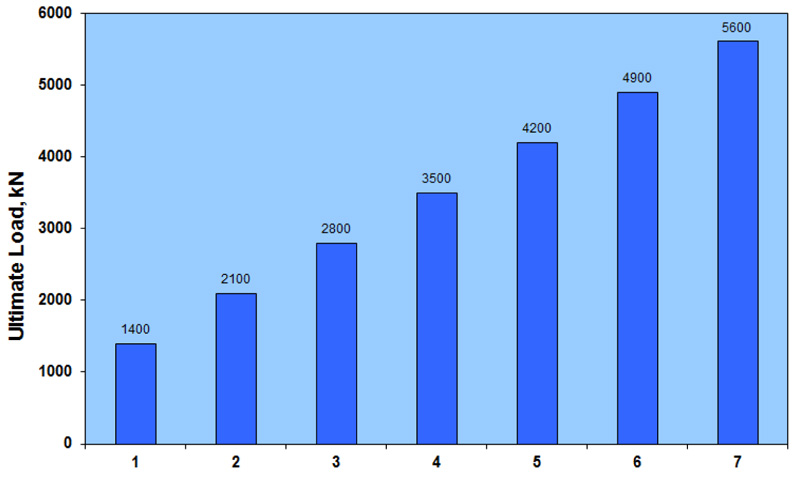
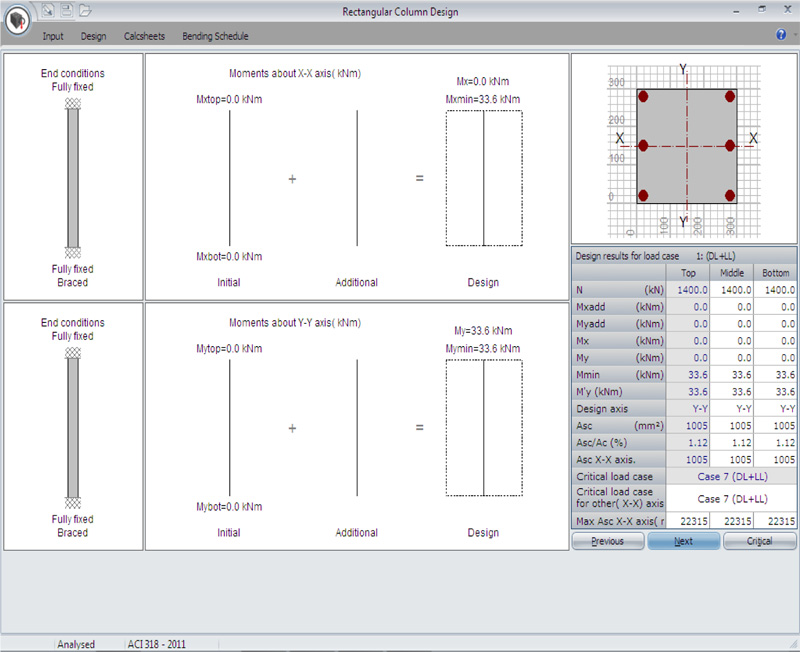

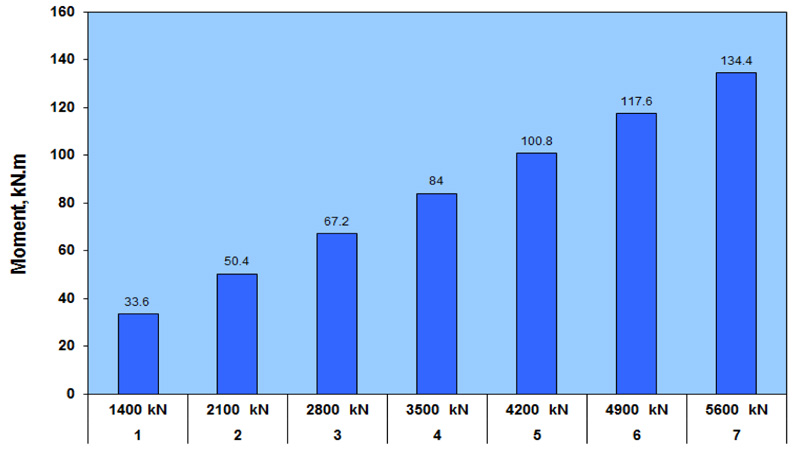
| Item |
Dead load (kN) |
Live load (kN) |
Ultimate load combination (kN) |
| 1 | 500 | 500 | 1400 |
| 2 | 750 | 750 | 2100 |
| 3 | 1000 | 1000 | 2800 |
| 4 | 1250 | 1250 | 3500 |
| 5 | 1500 | 1500 | 4200 |
| 6 | 1750 | 1750 | 4900 |
| 7 | 2000 | 2000 | 5600 |
4.1.3. Analysis Output Results of Program Prokon.V.3. for R.C. Columns
The same steps for analysis that are used for all samples with different parametric study, i.e load cases and ƒcu are shown in Table 6. By analyzing results, using the program package of Prokon V.3., the comparison is based on the ultimate moment, and steel reinforcing depending on the parameter (ƒcu) for the same load applied conditions. The same procedures that are used for all cases i.e. the effect of loads cases & ƒcu on behavior response of r.c. columns as shown in Table 7. it is possible to show that when the load increased, the moment strength capacity increased by about (20-50%), and steel reinforcing increased by about (250- 350%), keeping the same other properties kept constant.
4.1.4. Effect of Cubic Compressive Strength ƒcu on R.C. Column Behavior
From Fig. (10) that show the effect of varied ƒcu and load cases applied on steel reinforcing area, it is clearly shown that the results from the manual calculation are compatible with results from Program Prokon.V.3., i.e the increased value of ƒcu may give enhancement of the strength load capacity of columns by about in range (40-70%), (80-140%) and (120-215%) respectively. These values represent the difference between the reference column sample and high strength concrete. It can be shown by increased compressive strength by about (100% - 200%), leading to a decrease in the steel reinforcing ratio by about (15-20%), keeping the same other properties but not less than the minimum steel reinforcing ratio.
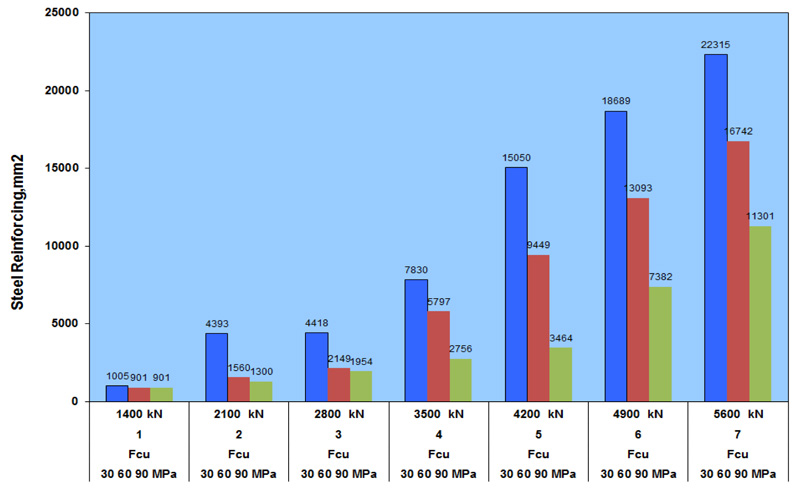
| Load Case | Load (kN) | ƒcu MPa | ƒcu MPa | ƒcu MPa |
| 1 | 1400 | 30 | 60 | 90 |
| 2 | 2100 | 30 | 60 | 90 |
| 3 | 2800 | 30 | 60 | 90 |
| 4 | 3500 | 30 | 60 | 90 |
| 5 | 4200 | 30 | 60 | 90 |
| 6 | 4900 | 30 | 60 | 90 |
| 7 | 5600 | 30 | 60 | 90 |
| Item | ƒcu=30 MPa | ƒcu=60 MPa | ƒcu=90 MPa | ||||
| Load Case | Load (kN) | Mmin (KN.m) | Asc (mm2) | Mmin (KN.m) | Asc (mm2) | Mmin (KN.m) | Asc (mm2) |
| 1 | 1400 | 33.6 | 1005 | 33.6 | 901 | 33.6 | 901 |
| 2 | 2100 | 50.4 | 4393 | 50.4 | 1560 | 50.4 | 1300 |
| 3 | 2800 | 67.2 | 4418 | 67.2 | 2149 | 67.2 | 1954 |
| 4 | 3500 | 84 | 7830 | 84 | 5797 | 84 | 2756 |
| 5 | 4200 | 100.8 | 15050 | 100.8 | 9449 | 100.8 | 3464 |
| 6 | 4900 | 117.6 | 18689 | 117.6 | 13093 | 117.6 | 7382 |
| 7 | 5600 | 134.4 | 22315 | 134.4 | 16742 | 134.4 | 11301 |
CONCLUSION
The conclusion is based on analysis results behavior of high performance R.C. columns which is divided into two parts:
ACI 318M-2011 Analysis Results Behavior
1-It is found that an increased Steel reinforcing ratio by about (100% -200%) may lead to an increased ultimate strength capacity of columns by about (20-25%), respectively.
2- with the R.C. columns under consideration by increasing cubic compressive strength of concrete ƒcu by about (100%, 200%, 300%), the ultimate strength load capacity is increased by about in range (40-70%), (80-140%) and (120-215%) respectively, these differences in range ratio are due to varied steel ratio that are used, i.e.(varied steel ratio 2%, 4%, and 8%) with different values of ƒcu.
3- Additionally, it was found that the suitable reinforcing ratio used was (2%) i.e. this value of ratio gives more enhancement, with an increased cubic compressive strength of concrete slightly from (100%-300%) of load-carrying capacity by about (70-215%), as compared with others steel ratio.
4- It is found that by increasing ƒcu i.e using high-performance concrete (high compressive strength concrete) more load capacity is given by about (40 - 215%) as compared with normal strength concrete.
5- When increasing compressive strength of samples columns i.e. (using high strength concrete), may be lead to a decreased longitudinal steel reinforcing ratio by about (15-20%) but not less than the minimum steel reinforcing ratio.
Program Package Prokon V.3. Analysis of Results Behavior
1- The amount of steel required is found to be decreased by about (15 -25%) with increases in the compressive strength of concrete for all cases i.e. (when increasing the ƒcu by about 100%-200%).
2- It is found that when the increasing load applied, it may be lead to increased steel reinforcing ratios of column according to varied cases.
3- The percentage difference between the areas of steel required by the load cases is calculated with the ACI-318M code 2011 as the baseline. For the combination of dead and imposed loads considered in this research; the average percentage difference for increased loads cases applied of all columns samples are about (100 -500%) in the range of different cases.
Finally, by comparing between analysis results behavior of high performance reinforced concrete columns of this comparative study, the following conclusions are shown:
1- At two cases of analysis ACI-318M code and Program Prokon V.3., that compatible results behavior and the columns sample are shown as the same trends results based on structural analysis results. The aims of analysis and designing are safe and economical structures.
2- Also, this comparative study can be used to evaluate the reinforced concrete columns at sites or by using the suitable commercial program of analysis based on the steel reinforcing ratio or compressive strength of concrete.
3- It is possible to compare the results obtained by manual calculations based on international references and compare them with the results obtained from the engineering programs available for this purpose. Hence, they can be adopted for the evaluation of structural parts, including concrete columns to solve engineering problems that occur during construction or during the life of the structure.
CONVERSION FACTORS
| cm | = 10 mm |
| in. | = 25.4 mm |
| Ib | = 4.4482 N |
| Psi | = 0.0068948 MPa |
| kg | = 9.81 N |
| MPa | = 145 Psi |
CONSENT FOR PUBLICATION
Not applicable.
AVAILABILITY OF DATA AND MATERIALS
All data of this paper used to support the findings of this study from experimental work are available from the corresponding author [H.N.G.A-M] upon request.
FUNDING
None.
CONFLICT OF INTEREST
The authors declare no conflict of interest, financial or otherwise.
ACKNOWLEDGEMENTS
This research is a part of national research studies treating the properties of high strength concrete columns. The author would like to thank Mustansiriayah University, Baghdad, Iraq (https://uomustansiriyah.edu.iq/) for its encouragement of this research work. Furthermore, the author also wants to express their gratitude to the College of Engineering for their support for conducting this research work successfully.


